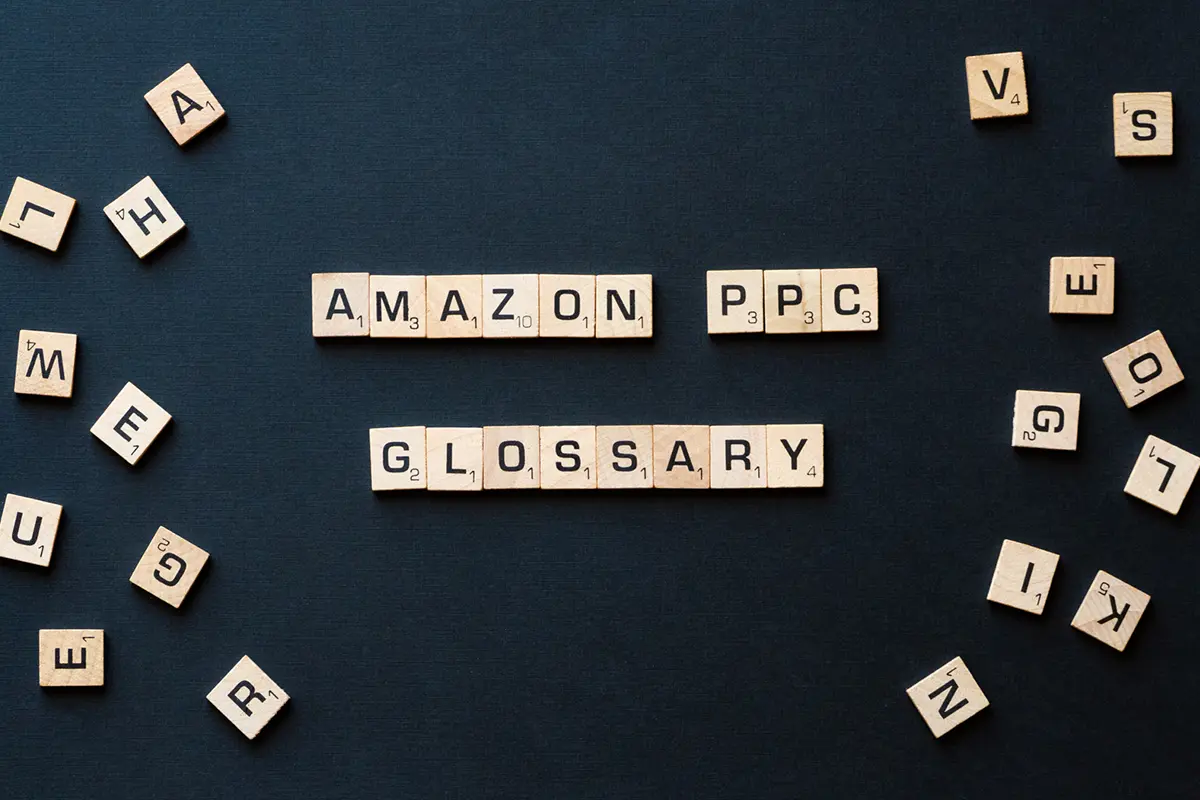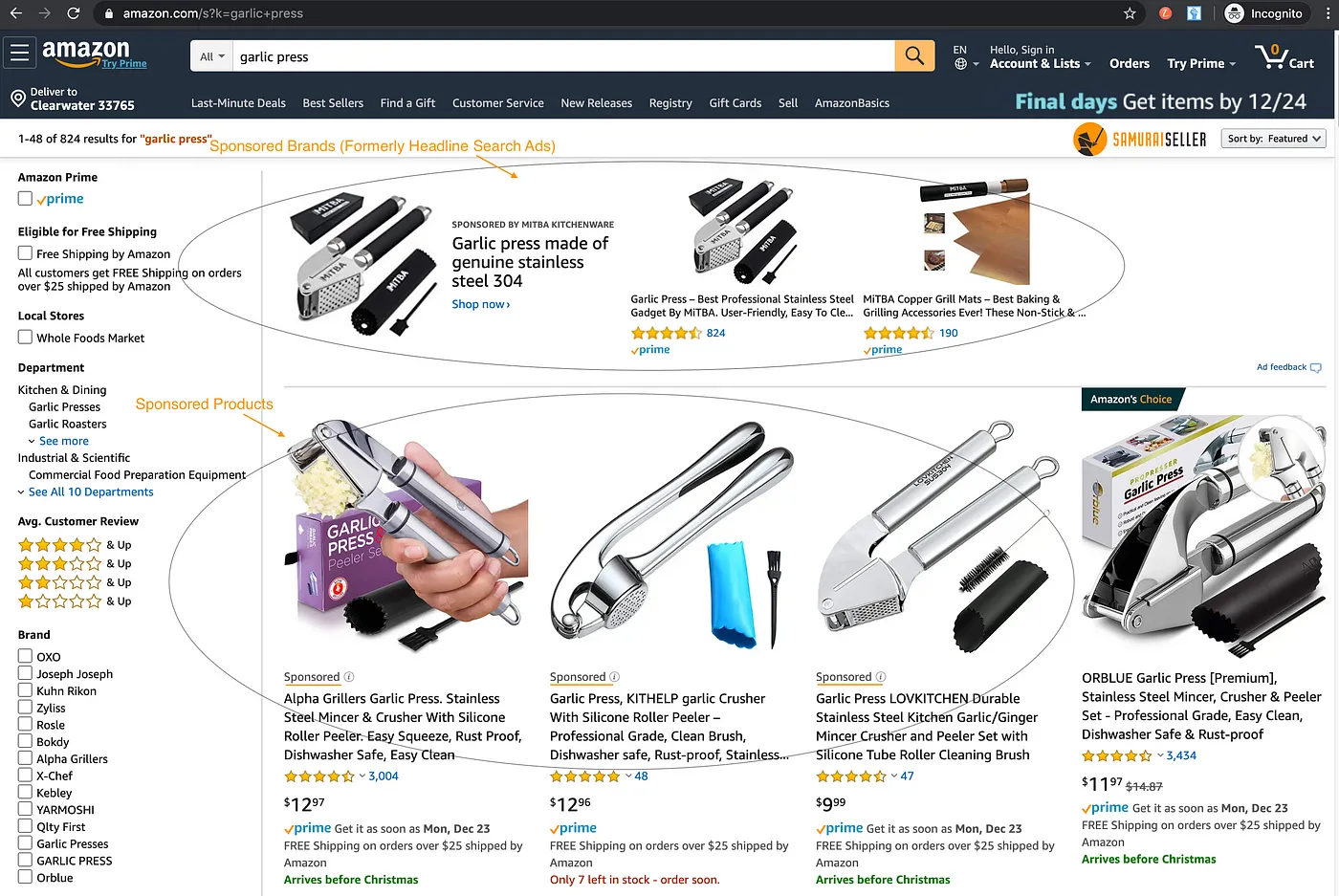
Aaron Cordovez
Amazon Entrepreneur & Samurai Seller Co-founder
- 7 min read
Amazon Advertising Glossary: A Beginners Guide to Amazon PPC
This is a general guide to the most important words used in Amazon advertising. If you grasp the words you will have a good idea of what advertising on Amazon is and can understand the numbers and metrics related to it.

Amazon PPC (Pay Per Click): A general term used to describe all things relating to advertising on Amazon’s own advertising platform. You pay Amazon for each click of your ads.
Examples: “I am good at Amazon PPC” “How much are you spending on Amazon PPC?”
Budget: How much you are willing to spend per day on advertising. You can set this up for your entire account, or for one ad.
Impression: When an ad shows up on Amazon.com (aka wins the auction) then Amazon records this as an impression. It can show at the bottom of the page, at the top, or wherever but if it was displayed at all, it is considered an impression.
Click: This is a single click of the mouse from a customer onto your ad. Amazon has software that identifies clicks that are fake or made by machines and removes clicks that they identify as invalid, you are then charged for the valid clicks.
CTR (Click Through Rate): The ratio of how often shoppers click on your product ad when displayed. This is calculated as clicks divided by impressions. (Amazon Definition)
Amazon loves higher Click Through Rate because they make more money for every Impression. Due to this, they reward higher click through rates with lower costs.
Spend: The amount Amazon is charging you for the clicks and ads.
CPC (Cost Per Click): This is the average amount you paid for each click on an ad. (Amazon Definition)
Orders: The number of Amazon orders shoppers submitted after clicking on your ads. (Amazon Definition)
A single order can include one or more items purchased.
Sales: The total dollar value of sales that are attributable to a certain ad (amount of sales the ad was responsible for). Amazon attributes a sale to an ad if the customer buys within a certain time after they click on your ad.
Note: It can take up to 12 hours for your sales data to update. As a result, sales data may be delayed in the “Today” date range. We recommend waiting until all sales data is populated before evaluating campaign performance. (Amazon Advice)
7 Day Sales: The amount of Sales the ad is responsible for up to 7 days after the click occurs. Amazon’s Campaign Manager inside Seller Central shows 7 Day Sales. This includes purchases of the product you are advertising, but also other products, for example another color of the same product.
30 Day Sales: The amount of Sales the ad is responsible for up to 30 days after the click occurs. For Software developers getting data from Amazon, they make up to 30 days of data available, which is more accurate.
Advertised SKU Sales: This is the amount of Sales done for the product that was being advertised. It does not include sales of another color, size, or another product in your catalog.
Other SKU Sales: This is the amount of Sales done for OTHER products than that which was being advertised.
ACoS (Advertising Cost of Sale): How much money you spent per sale, as a percentage. If you spent $3.00 to get $10.00 in Sales, your ACoS would be 30%. If you spend $15 advertising to get $10 in Sales, your ACoS would be 150%.
A very general best practice is not to have a higher ACoS than your profit margin on an item, so you are not losing money on advertising.
Total ACoS (Sometimes called TACOS): This is the ratio between your total advertising spend on Amazon versus your total gross sales on Amazon. If on your entire account, you sell $100,000 in a month and spend $3,000 on Ads in that month, your Total ACoS would be 3%. This is a good number to be aware of. Normal Total ACoS ranges from low 3% to a very high at 30%.
Ad: The image, text and price and other details about the product, shown in a particular way with the purpose of interesting a customer in your product.
Target (or Targeting): The way that Amazon allows you to select who will be seeing your ad. It can be based on a customer’s search, or it can be based on the interest of the customer, it can be based on what page they are currently on, or it can even select people who have previously visited your product pages or competitors.
Bid: An advertiser’s maximum amount they are willing to spend to have their ad show. If your bid is $5, it does not mean that an advertiser will spend $5 for every click, but it does mean Amazon is saying that you will NOT pay more than $5 for a single click.
Default Bid: A bid set for a group of ads which is the default for all targets initially until they are changed.
Ad Group: An ad group is made up of one or more ads, one or more targets and a default bid. The ad group can be given a name but that is not seen by the customer.
Campaign: A set of ad groups that share one advertising budget. This can be used to control spending. Every ad created is created within a campaign and an ad group. A campaign name is never seen by the customer on Amazon.
Conversion: A conversion is when you sell a customer. You have “converted” the shopper from a window-shopper to a customer, you converted them from someone who was just browsing to an actual customer who has made a purchase. If you make 3 sales, that would be 3 conversions.
Conversion rate: The percentage of shoppers that bought something, compared to the total number of shoppers that visited the page (or clicked the ad). Your ad’s conversion rate would be total clicks divided by total ad conversions/orders. So if you got 10 clicks and 2 conversions (purchases) the conversion rate would be 20%.
Session: This is when a person goes to your product page, whether through an ad or not.
Unit Session Percentage: Amazon’s version of conversion rate which counts the number of UNITS sold rather than orders placed. It is: Units Sold divided by Number of Sessions. This number can be over 100%. If 10 people visited your page and only 1 person bought, your conversion rate is 10%, but if that person bought 20 units, the Unit Session Percentage would be 200%.
Auction: Amazon’s method of choosing which ads to place in the available advertising spots on a page on Amazon. Any ad that shows up, has won the auction. Being shown is dependent on two things: 1) Relevancy of your Ad 2) Your Current Bid
Manual Bidding: The advertiser selects exact searches or exact product listings to place their ad on. This is opposed to allowing Amazon to choose where your ad will go. This form of advertising is the most efficient in the long run because you can waste less money on customers who do not want your product.
Automatic Bidding: Amazon’s method of looking at your listing and then deciding which customers they will show your ads to. These kinds of ads show up both in search results and on product detail pages (product listings). You have less control of your ads, however you can find new keywords.
Campaign Manager: The place in Seller Central where you can view your advertising performance for your account, as well as make changes to your bids, keywords and other things. Not all information is available in Campaign Manager, but a lot is.
Organic (Organic Results): This is the position of a product that is not paid for to show up. Amazon uses its own methods to place the best products it thinks the customers want to buy based on their location, search etc.
Sponsored: Amazon uses this word to show that a product result is paid for by the seller and is not organic.
Sponsored Products: The type of advertising on Amazon that is most used. It includes the advertising types that blend in with normal results. Many customers do not see the “Sponsored” tag on the product and think it is part of the regular results. This also includes the “Sponsored products related to this item” on the product page.
Sponsored Brands: (formerly Headline Search Ads) are keyword-targeted ads that show up at the top of search or below search. They allow brands to promote several products with a custom headline and logo. These ads can only be used by sellers who represent a brand on Amazon, aka Brand Owners. A full FAQ on Sponsored Brands can be found on Amazon’s Sponsored Brands Page.

Advanced Words
Keyword: Generally, this means what a customer enters into the search bar on Amazon.com. This general definition does not fit the Amazon Advertising definition.
When referring to Keywords inside of an Ad campaign on Amazon, keyword is a targeting type to say WHICH Customer searches you want to enter in the auctions for. It can include many searches, not just one.
“banana slicer” as a Broad Match keyword will target customers searching for “banana slicer”, “banana slicers”, “best banana slicer”, “slicer for yellow bananas” and much more. Each of the searches are called Customer search terms.
Broad Match: A type of targeting which takes a keyword and can show the ad to the customer if they type in parts of the keyword in any order.
Phrase Match: A type of targeting which takes a keyword and will show it to customers searching those words in that order, but also can include additional words in the beginning and the end.
Exact Match: A type of targeting which takes a keyword and will show it to customers searching those words in that order and ONLY in that order and have no additional words. However this targets the Keyword also in plural or singular form.
Customer search term: Exactly what the customer typed in to Amazon.